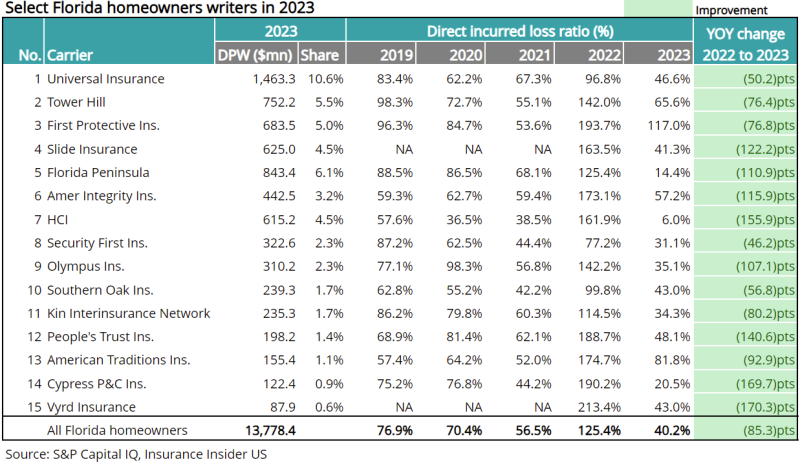
Florida reinsurance buyers are starting their renewal discussions well in advance of the June 1 start to the hurricane season this year. After a hurricane-light year, industry sources are trying to get a handle on supply and demand dynamic for the 2024-25 renewal cycle.
Sources agreed that overall reinsurers are pushing to keep rates and retentions in line with last year, while insurers are looking for better terms. That said, overall rate expectations are flattish to single digit increases, which could soften closer to June 1.
There could be rate decreases in upper layers, but layers closer to and below the Florida Hurricane Catastrophe Fund (FHCF) attachment point will likely see rate increases.
Sourcing low-tier reinsurance capacity is still expected to be a challenge for poorly capitalized domestic carriers, but supply in upper layers is expected to be well oversubscribed.
Also, a major topic of discussion in renewal conversations has been the revision of Hurricane Ian estimates—some carriers have been able to lower theirs, while others have or will need to raise reserves.
On the demand side, several factors are playing into the renewals including the Reinsurance to Assist Policyholders (RAP) layer being discontinued, the Cat Fund’s retention increasing, modeling firm requirements increasing, exposure growth, Citizens potentially purchasing more reinsurance and Citizens take-outs by new and existing carriers.
Take-outs and exposure growth will support what sources expect to be significant reinsurance demand. These estimates ranged from $3bn up to as high as $5bn, which represents at least a 10% uplift on private reinsurance limit placed in the state.
One source said that Florida saw overall TIV growth of 42% in average Coverage A (dwelling cover) from mid-2019 to mid-2023, or roughly 10.5% per year, according to QUASR data.
“All things equal, with Citizens shrinking and TIV growing, Florida would demand more limit,” he said.
Citizens buys its reinsurance at higher attachments relative to private, thinly-capitalized insurers, so depopulation efforts typically drive up private reinsurance requirements.
Meanwhile, on the supply side, sources noted increased activity in the ILS and cat bond markets that will match any demand in the upper layers.

New demand
There are several demand sources for this year’s renewals. First, many sources pointed out that the RAP layer – introduced in 2022 – will not be available for insurers to take advantage of, which means $1bn of capacity will need to be replaced in the open market.
One executive noted that while the industry is “hanging its hat on the disappearance of the RAP layer”, it is a one-time event, and companies already had to buy more open market cover for second events last year. He added that because of this, companies are well prepared for this scenario.
Last year, among others, Universal and Heritage elected to use the RAP program, established in May 2022, after deferring in 2022. Meanwhile, insurers have not really utilized the Florida Optional Reinsurance Assistance (FORA) program – passed in December 2022 – and sources don’t expect that to change.
The Cat Fund’s retention is also expected to increase, part of which will contribute to new demand. In 2023, FHCF coverage triggered above $9.1bn. The exact number of the increase is not clear yet but will be released in the next few weeks.
Sources added that one of the biggest contributors to increased demand will be the impact of Moody’s RMS v23 model update.
Moody’s RMS has been rolling out its v23 model, which is expected to increase losses by between 5% to 40% depending on the portfolio, Gallagher said in a report that analyzed the impact based on client portfolios.
In Florida, the increases averaged 10%-20% at the one-in-100-year level.
Outside Florida, the model change has contributed to the Texas Windstorm Insurance Association (Twia) potentially seeking to purchase an additional $1.5bn in limit to give it $3.7bn of reinsurance for 2024-25.
Sources added that they expect Citizens to purchase more coverage this year to avoid emergency assessments. Citizens CEO Tim Cerio told board members in December that Citizens has ample reserves and the ability to acquire reinsurance to cover a one-in-100-year storm without having to levy assessments on non-Citizens policyholders.
Sources also noted that about 212,000 new single-family housing units were authorized in Florida in 2022, the second most behind Texas, according to an analysis of US Census data by Construction Coverage. They added that that rate prevailed in 2023 and should continue in 2024.
Depopulation efforts
Another major driver of increased demand is Citizens depopulation efforts from new and existing carriers since the last renewal.
In 2023, Citizens Depopulation Program transitioned 223,307 policyholders to private insurance companies approved by the Florida Office of Insurance Regulation (Floir). More policies have been removed through depopulation this year than the 176,682 removed between 2016-2022 combined.
As a result, Citizens revised its 2023 year-end policy count and exposure projections from 1.7 million policies and $675bn in total exposure to 1.22 million policies and $551bn in total exposure.
As of January 31, the insurer-of-last-resort had 1.16 million policies in force, compared to 1.23 million on December 31.
In March, Floir approved three Florida carriers to assume as many as 54,000 policies from Citizens.
According to consent orders dated February 29, Slide Insurance was approved to assume as many as 25,000 policies; American Integrity Insurance was approved for up to 19,386 policies; and Security First Insurance was approved for up to 10,000 policies. The assumptions will be made starting on May 21.
Also, last month, this publication reported that Sypher is looking to raise capital to launch a reciprocal in Florida.
Among the new formations, Orange Insurance Exchange, a reciprocal insurer, announced in November its plans to offer property insurance in the Florida market, led by former Tower Hill president Don Matz and Cabrillo CEO Michael McNitt.
Also in November, HCI-sponsored Condo Owners Reciprocal Exchange (Core) received its certificate of authority from the Florida Office of Insurance Regulation to transact insurance in the state, after receiving initial operating approval earlier that month. This followed an April approval for HCI to set up a domestic carrier, Tailrow Insurance, writing homeowners’ multi-peril business.
The supply side
On the supply side of the equation, the cat bond market has been one source of fresh inflows that multiple carriers have tapped well ahead of the start of the season, providing more support than in years past.
With a few deals still marketing, the aggregate amount of Florida cat bonds issued in Q1 is shaking out to roughly $955mn, according to data from sister title Insurance Insider ILS.
More broadly, the cat reinsurance market began to function in a more orderly way last year, following the lock-up of late 2022. Many reinsurers are highlighting the attraction of higher rates in the property cat class – yet supply is still restrained, due to caution over total aggregate exposures and reinsurers continuing to look for more remote-attaching risk.
Sources expect cat bond capacity to match and even exceed the demand requirements in the upper layers, especially given the attractive pricing to ILS investors.
Reinsurers also noted that given the challenges in the casualty space, more capacity could be dedicated to property.
On the traditional reinsurance side, sources noted that reinsurers are looking to grow on certain programs.
Sources added that reinsurers have been open to discussing covers they’ve shied away from for several years including third and fourth event cover, aggregate cover and top and down cover. That said, those covers will still come at a price, they added.
Revised Ian loss estimates
Hurricane Ian loss estimates have been mentioned in almost every renewal conversation, sources said.
On one hand, insurers like HCI significantly reduced their ultimate expected loss for Hurricane Ian, which has fallen from $960mn in September 2022, to $845mn by year-end 2022 and falling further to $740mn at the end of 2023.
“While we have lowered the ultimate by more than $200mn to date, we are still at the top of the actuaries’ range for this storm”, CFO James Harmsworth said on last week’s earnings call.
On the other hand, companies like American Integrity have increased their Hurricane Ian losses. The Floridian revised its estimate in December to $861mn, but sources expect losses to rise higher than that.
American Integrity’s $150mn Integrity Re 2020-1 cat bond is now expected to be a full loss, up from an expected loss of closer to $64mn in late 2023.
Meanwhile, American Coastal president Brad Martz said the Floridian is bracing for a “much bigger core catastrophe renewal at June 1 of this year”, for which the firm reserved most of the proceeds from $38.2mn raised from an offering of 4.4 million shares.
Based on feedback from January 1 and February 1 renewals, the executive said reinsurers are “hungry”, but remain disciplined.
Universal CEO Steve Donaghy said that Universal’s first event 2024-25 reinsurance tower is 90% secured, and the carrier has negotiated additional multi-year capacity for the future.
“We haven't completed it at this point, and if the open market comes in at a competitive rate, we would consider that in lieu of [multi-year deals]. But as I sit here today, I think we would continue, and it worked out very well for the company last year,” he said.
